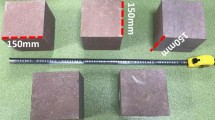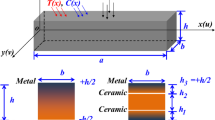Abstract
The master curve of a viscoelastic variable is of significance due to its capability of characterizing the linear viscoelastic (LVE) property in an extended time or frequency range. However, the master curves constructed using the traditional approach fail to strictly comply with the LVE theory, leading to inaccurate predictions in the extended range. In order to address this issue, a framework was developed for the LVE characterization of asphalt mixtures. The generalized logistic sigmoidal model was adopted as the master curve model of storage modulus. A numerical model of loss modulus was established in relation to the continuous relaxation spectrum, whose mathematical model was derived in light of its relationship with the storage modulus. The model parameters determined using the storage modulus and loss modulus test data were employed to construct the master curves of storage modulus, loss modulus, dynamic modulus and phase angle. Then the relaxation modulus master curve was generated by establishing a numerical model. Afterwards, the continuous retardation spectrum was solved numerically based on its relationship with the continuous relaxation spectrum. The master curves of storage compliance, loss compliance and creep compliance were obtained using the corresponding numerical models that were established with respect to the continuous retardation spectrum. The interrelationship among the viscoelastic variables was then employed to obtain the dynamic compliance and phase angle master curves. It was demonstrated that the developed framework ensured the master curves of all viscoelastic variables complied with the LVE theory.











Similar content being viewed by others
References
Olard F, Di Benedetto H (2003) General “2S2P1D” model and relation between the linear viscoelastic behaviours of bituminous binders and mixes. Road Mater Pavement Des 4(2):185–224
Ferry JD (1980) Viscoelastic properties of polymers, 3rd edn. Wiley, New York
Findley WN, Lai JS, Onaran K (1989) Creep and relaxation of nonlinear viscoelastic materials with an introduction to linear viscoelasticity. Dover Publications, Mineola
Tschoegl NW (1989) The phenomenological theory of LVE behavior: an introduction. Springer, New York
Schapery RA (1984) Correspondence principles and a generalized J integral for large deformation and fracture analysis of viscoelastic media. Int J Fract 25(3):195–223
Zhang Y, Luo R, Lytton RL (2012) Characterizing permanent deformation and fracture of asphalt mixtures by using compressive dynamic modulus tests. J Mater Civ Eng 24(7):898–906
Darabi MK, Al-Rub RKA, Masad EA et al (2011) A thermo-viscoelastic–viscoplastic–viscodamage constitutive model for asphaltic materials. Int J Solids Struct 48(1):191–207
Applied Research Associates (ARA) (2004) Guide for mechanistic-empirical design of new and rehabilitated pavement structures. National Cooperative Highway Research Program (NCHRP) Project 1-37A, Transportation Research Board, Washington, DC
ASTM (2003) Standard test method for dynamic modulus of asphalt mixtures. ASTM D3497, West Conshohocken
AASHTO (2007) Standard method of test for determining dynamic modulus of hot mix asphalt (HMA). AASHTO TP 62-07, Washington, DC
AASHTO (2011) Standard method of test for determining the dynamic modulus and flow number for hot mix asphalt (HMA) using the asphalt mixture performance tester. AASHTO TP 79-11, Washington, DC
Gibson N, Schwartz C, Schapery R, Witczak M (2003) Viscoelastic, viscoplastic, and damage modeling of asphalt concrete in unconfined compression. Transp Res Rec J Transp Res Board 1860:3–15
Yun T, Underwood BS, Kim YR (2010) Time-temperature superposition for HMA with growing damage and permanent strain in confined tension and compression. J Mater Civ Eng 22(5):415–422
Park SW, Schapery RA (1998) Methods of interconversion between LVE material functions Part I–a numerical method based on Prony series. Int J Solids Struct 36(11):1653–1675
Zhao Y, Liu H, Bai L, Tan Y (2013) Characterization of LVE behavior of asphalt concrete using complex modulus model. J Mater Civ Eng 25(10):1543–1548
Liu H, Luo R (2017) Development of master curve models complying with LVE theory for complex moduli of asphalt mixtures with improved accuracy. Constr Build Mater 152:259–268
Park SW, Kim YR (2001) Fitting prony-series viscoelastic models with power-law presmoothing. J Mater Civ Eng 13(1):26–32
Zhao Y, Ni Y, Zeng W (2014) A consistent approach for characterising asphalt concrete based on generalised Maxwell or Kelvin model. Road Mater Pavement Des 15(3):674–690
Levenberg E, Shah A (2008) Interpretation of complex modulus test results for asphalt-aggregate mixes. J Test Eval 36(4):326–334
Levenberg E (2011) Smoothing asphalt concrete complex modulus test data. J Mater Civ Eng 23(5):606–611
Bhattacharjee S, Swamy AK, Daniel JS (2012) Continuous relaxation and retardation spectrum method for viscoelastic characterization of asphalt concrete. Mech Time Depend Mater 16(3):287–305
Liu H, Luo R, Lv H (2018) Establishing continuous relaxation spectrum based on complex modulus tests to construct relaxation modulus master curves in compliance with LVE theory. Constr Build Mater 165:372–384
Luo R, Lv H, Liu H (2018) Development of Prony series models based on continuous relaxation spectrums for relaxation moduli determined using creep tests. Constr Build Mater 168:758–770
Lv H, Liu H, Tan Y, Sun Z (2019) Improved methodology for identifying Prony series coefficients based on continuous relaxation spectrum method. Mater Struct 52(4):86. https://doi.org/10.1617/s11527-019-1386-1
Booij HC, Thoone GPJM (1982) Generalization of Kramers–Kronig transforms and some approximations of relations between viscoelastic quantities. Rheol Acta 21(1):15–24
Parot JM, Duperray B (2007) Applications of exact causality relationships to materials dynamic analysis. Mech Mater 39(5):419–433
Rowe G, Baumgardner G, Sharrock MJ (2009) Functional forms for master curve analysis of bituminous materials. In: Advanced testing and characterization of bituminous materials. CRC Press, Boca Raton, pp 81–91
Williams ML, Landel RF, Ferry JD (1955) The temperature dependence of relaxation mechanisms in amorphous polymers and other glass-forming liquids. J Am Chem Soc 77(14):3701–3707
Author information
Authors and Affiliations
Corresponding author
Ethics declarations
Conflict of interest
The authors declare that they have no conflict of interest.
Additional information
Publisher's Note
Springer Nature remains neutral with regard to jurisdictional claims in published maps and institutional affiliations.
Rights and permissions
About this article
Cite this article
Liu, H., Zeiada, W., Al-Khateeb, G.G. et al. A framework for linear viscoelastic characterization of asphalt mixtures. Mater Struct 53, 32 (2020). https://doi.org/10.1617/s11527-020-01468-x
Received:
Accepted:
Published:
DOI: https://doi.org/10.1617/s11527-020-01468-x




